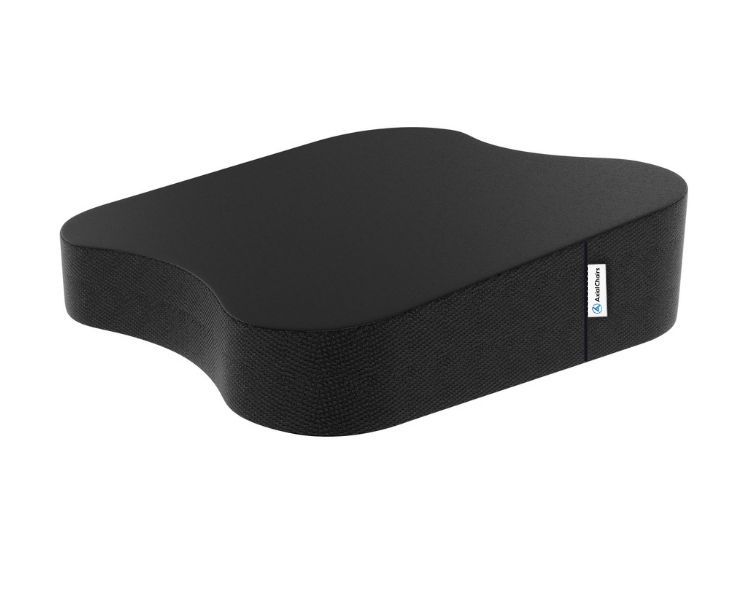When we talk about chairs, they’re not just pieces of furniture. They’re a daily companion to many, playing a crucial role in our overall health and wellbeing, particularly concerning our spine. As a chiropractor and mattress designer, I’ve spent considerable time studying the interaction between the human body and its resting surfaces. Chairs, undoubtedly, are on the frontline of this exploration.
As a general rule, A chair that effectively prevents back pain should offer both comfort and support, incorporating various customization options like adjustable seat height, depth, tilt, armrests, headrests, and lumbar backing. It’s essential for the seat material to adequately support the lower back, promoting proper posture and minimizing tiredness.
I’ve spent most of my adult life studying and treating back pain, primarily due to poor sitting posture. Back pain when sitting is a common issue that affects just about everyone today. As someone who has been practicing chiropractic for over three decades and also trained as an ergonomist, I have the knowledge and experience needed to help alleviate this problem.
I have written a book on posture, appeared on national TV to discuss this topic, a YouTube channel on this subject, and developed products to help people improve their posture and comfort while sitting. I even successfully crowdfunded a project to create a set of ergonomic seat cushions. I am confident that I can steer you into the right direction. so, let’s dive deep into the anatomy of a chair and how its design can be the cause of that nagging back pain many people experience.
1. Lack of Lumbar Support
Why it’s problematic: The lumbar region (lower back) has an inward curve known as the lumbar lordosis. Without proper support, this curve can flatten out or even reverse, leading to muscle strain and disc pressure.
Technical Explanation: Chairs that lack lumbar support or have an improperly designed one can lead to a forward tilt of the pelvis. This, in turn, increases the strain on the lumbar discs and the posterior spinal ligaments, potentially causing or exacerbating low back pain.
2. Improper Seat Depth
Why it’s problematic: If a chair is too deep, it can force the user to sit forward, eliminating back support. On the other hand, a seat that’s too shallow can cause pressure on the sitting bones (ischial tuberosities).
Technical Explanation: An improper seat depth can cause users to either slouch or perch on the edge of the chair. Slouching can contribute to the loss of the natural lumbar curve, while perching can lead to increased pressure under the thighs, hindering blood flow and potentially leading to muscle fatigue and discomfort.
3. Non-adjustable Backrest Angle
Why it’s problematic: A fixed backrest angle can force the spine into a posture that might not be ideal for every individual, given the variations in spinal curvature and body sizes.
Technical Explanation: The spine isn’t a straight line; it has natural curves. A chair that doesn’t allow for an adjustable backrest angle won’t cater to these curves effectively. Over time, this can result in muscular imbalances, as some muscles become overactive while others weaken, leading to postural anomalies and discomfort.
4. Hard Seating Material
Why it’s problematic: Seating materials that are too hard can increase pressure points, leading to discomfort, reduced blood circulation, and muscle fatigue.
Technical Explanation: A very firm seating surface does not distribute the body weight evenly. This uneven distribution creates pressure points, especially around the sitting bones and the thighs. Over prolonged periods, this can lead to reduced blood circulation, potentially causing numbness and pain.
5. Lack of Seat Pan Tilt
Why it’s problematic: A static, non-tilting seat can hinder the natural pelvic tilt, leading to a flattened lumbar curve.
Technical Explanation: The ability to slightly tilt the seat can enhance the natural forward tilt of the pelvis, which can aid in maintaining the lumbar curve. A chair without this feature can contribute to lumbar strain.
My Best Secret To Enhance the Natural Forward Tilt
The forward-leaning function of your chair is essential for those looking to prevent persistent lower back discomfort. This feature aids in counteracting the natural tendency to slouch when sitting for long durations. By gently angling your hips forward, it supports a more beneficial spinal position. Generally, it’s advisable to have your hips sit above the level of your knees, with some guidelines suggesting an angle of up to 20°. This position lessens strain on the lumbar region and fosters improved posture. Adjusting the seat angle can help mitigate the stress from prolonged sitting, leading to enhanced blood flow.
I explain the concept of my ergonomic design on a TV show HERE
Doctor's Recommendation
Black Friday Offer!
Get 35% off Orthopedic Seat Cushion
Product DetailsResearch-based Design
Recommended ForBack Discomfort
Video Guide
Video Guide
Developing a Well-Supported Forward Tilt for Ergonomic Chair: Insights and Considerations
For an optimal seating experience, it’s essential to consider several factors, with customizing the chair being crucial. There are numerous methods to achieve this, including adding supportive cushions and backrests. These enhancements reduce strain on your back and legs, promoting better comfort and posture for longer periods of sitting. Additionally, ensure your feet rest squarely on the ground and that ample room exists between your chair and desk. By following these suggestions, an ordinary chair can transform into a comfort-centric space that promotes ongoing health and wellness.
Ergonomic Comfort Cushion
An adaptable ergonomic cushion (as seen above) can be used to properly position your spine and enhance stability. This high-quality natural latex pad helps in strengthening core muscles, while alleviating strain in areas like the neck and shoulders. Moreover, maintaining an upright position eases pressure on the hips and knees since it activates a broader range of muscles than leaning back on a soft surface. Such a straight sitting habit helps in avoiding stress-triggered tendencies that individuals might inadvertently adopt during tasks.
Axial Ergonomic Seat Cushion® | Seat Chair Wedge
Quick Guide: A 30-Second Summary

All Day Comfort & Support
Product Name
Axial Designs™ Seat Cushion
Price
$149
Warranty
1 Year
Type
Posture Wedge
Top Layer
100% Natural Latex (Molded)
Bottom Layer
High-Density Foam
Top Material
Isometric Grippy Vegan Leather
Bottom Material
Non-Slip Material
Side Material
3D Breathable Fabric
6. Inadequate Seat Width
Why it’s problematic: A narrow seat can constrain the hips, causing discomfort and potentially affecting the alignment of the spine.
Technical Explanation: Constricting the hips can lead to an altered pelvic posture. This alteration can cascade upwards, affecting the alignment of the lumbar and thoracic spine, leading to potential musculoskeletal problems.
7. Absence of Armrests or Poorly Designed Ones
Why it’s problematic: Without proper arm support, there’s additional strain on the shoulders and upper back.
Technical Explanation: Armrests provide a place to rest the forearms, reducing the weight the shoulders have to bear. If the armrests are too high, they can elevate the shoulders leading to tension in the neck and upper back. If too low, they’re essentially useless and may cause the user to lean to one side, causing misalignment.
8. Non-Breathable Materials
Why it’s problematic: Materials that don’t allow for air circulation can cause discomfort due to heat and sweat.
Technical Explanation: Sitting for prolonged periods can generate a significant amount of heat, and if the material of the chair doesn’t allow for breathability, it can lead to excessive sweating and discomfort. This might seem like a minor issue, but discomfort from heat can lead individuals to adopt poor postures or shift frequently, which can indirectly contribute to back pain.
9. Static Chair Design Without Movement
Why it’s problematic: Chairs that don’t allow for movement can contribute to muscle stiffness and reduced blood circulation.
Technical Explanation: Dynamic chairs that allow for slight movement or rocking can be beneficial in promoting better blood circulation and reducing muscle fatigue. A static design can lead to stiffness as muscles remain in a constant state without relief.
10. Incorrect Chair Height
Why it’s problematic: If a chair is too high, it can cause the feet to dangle, placing stress on the thighs. If too low, it can result in an increased bend at the knees, which can put pressure on the lower back.
Technical Explanation: The height of the chair should allow for the feet to rest flat on the ground without excessive pressure on the back of the thighs. Incorrect chair height can change the angle of the pelvis and impact the natural curvature of the spine, leading to potential back pain over time.
Research: What Kind of Chairs Cause Back Pain
The following studies underscore the significance of ergonomically designed chairs in preventing back pain. Proper support and alignment are critical for the lumbar region, especially for those who spend prolonged hours seated, such as students and office workers.
Comparative study of two different kinds of school furniture among children (B Troussier – Ergonomics, 1999 – Taylor & Francis)
- This study examined the effects of two types of school furniture on children. It concluded that inappropriate furniture can lead to poor posture among students, which may contribute to back pain later in life. The right furniture can support proper spinal alignment, reducing the risk of back-related problems.
European guidelines for prevention in low back pain: November 2004 (Guidelines for Prevention in Low Back Pain – European Spine)
- This guideline from the European Spine Journal discusses preventive measures for low back pain. One notable recommendation is the importance of ergonomically designed seating in preventing back pain. Seating that doesn’t support the lumbar region can lead to back pain, emphasizing the importance of proper chair design.
Evaluation of risk factors causing musculoskeletal disorders using QEC method in a furniture producing unite (M Mirmohamadi, JN Seraji, J Shahtaheri)
- This research utilized the Quick Exposure Check (QEC) method to assess risk factors in a furniture-producing environment. The study found that poorly designed furniture increases the risk of musculoskeletal disorders among workers, underlining the importance of ergonomically sound furniture.
Changing standards for school furniture (AC Mandal – Ergonomics in design, 1997 – journals.sagepub.com)
- Mandal’s research delves into the evolving standards for school furniture design. It suggests that stagnant and outdated furniture standards may lead to discomfort and musculoskeletal issues for students. Updated standards that prioritize ergonomic design can help prevent back pain.
Alterations of the lumbar curve related to posture and seating (JJ Keegan – JBJS, 1953 – journals.lww.com)
- Keegan’s (brilliant!) study examines how seating can influence the lumbar curve’s natural shape. The research indicates that prolonged seating in non-supportive chairs can lead to alterations in the lumbar curve, a potential precursor to back pain.
Office furniture design–correlation of worker and chair dimensions (G Adu, S Adu, B Effah, K Frimpong-Mensah)
- This study investigates the correlation between worker dimensions (the perusual height, weight, etc.) and chair dimensions. Findings suggest that mismatched chair and worker dimensions can lead to discomfort and back pain. Ergonomic chair design tailored to individual worker dimensions can mitigate these issues.
Effects of chair design on back muscle fatigue (JR Cram, I Vinitzky – Journal of Occupational Rehabilitation, 1995 – Springer)
- Cram and Vinitzky’s research investigates how chair design can impact back muscle fatigue. The study concludes that chairs lacking ergonomic support can increase back muscle fatigue, potentially leading to discomfort and pain over time.
Specific flexion-related low back pain and sitting: comparison of seated discomfort on two different chairs (M O’Keeffe, W Dankaerts, P O’Sullivan, L O’Sullivan… – Ergonomics, 2013 – Taylor & Francis)
This research specifically focuses on flexion-related low back pain when seated. The comparison of two chair designs reveals that chairs lacking proper lumbar support can exacerbate flexion-related discomfort, emphasizing the importance of chairs that support the natural curvature of the spine.
Final Thoughts:
Finding the right chair is more than just aesthetics and price. For those who spend significant time sitting, it’s an investment in health. Knowing the pitfalls in chair design can empower you to make choices that are not only comfortable in the short term but also beneficial for long-term spinal health. Always remember, periodic movement, stretches, and breaks from sitting can also aid in reducing the risks associated with prolonged seating. After all, the best posture is the next posture.






